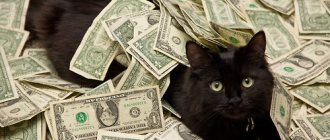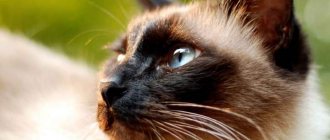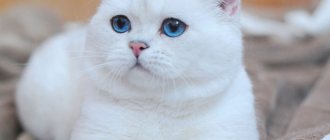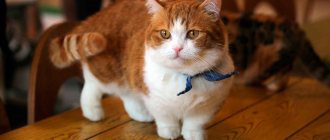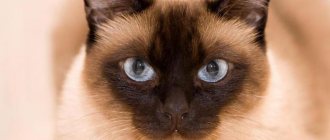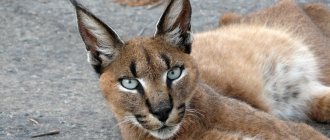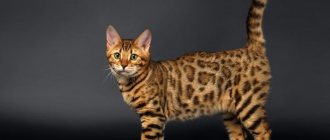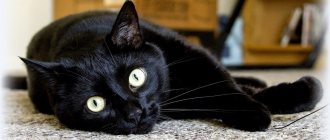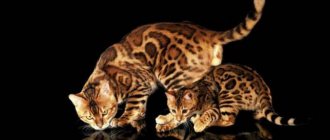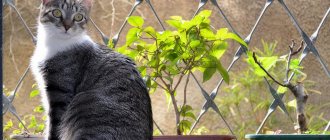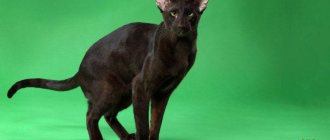What will you learn from the article?
- Tabby cat breeds
- Features of Australian Mist
- American Wirehair
- American Curl
- Asian tabby
- Jungala
- Kurilian, American Bobtail
- Maine Coon
- Manx
- Pixiebob
- Toyger
- Ceylon cat
- Siberian cat
The most common color among domestic cats is dark stripes against a lighter coat. Striping is not a distinctive feature of any breed. Many types of domestic cats can boast tiger stripes on their fur coats.
British shorthair smoky cat
This is perhaps one of the most famous and beloved breeds in the post-Soviet space.
It was officially registered in the 19th century by the British. In the same century, the first exhibition was held, at which power-hungry and proud British cats were presented. British shorthair cat
Breed Features
In most cases, these are strong and robust cats. They grow to medium or large sizes. The maximum weight of the “British” is 8 kg (males) and 5 kg (females). Cats of this breed grow up to 5 years old.
Table 2. Distinctive features of the British Shorthair cat.
| Cat body part | Breed Features |
| Torso | Strong, big-boned. Muscular. The back is quite massive. The proportions are correct |
| Head | The shape is regular and round. The skull is wide. The muzzle has a round shape. Tall individuals always have convex cheeks. It seems that the cat is constantly smiling |
| Ears | The ears are set wide and low. Rounded at the top, small sizes |
| Eyes | Large, round, orange eyes. Wide set |
| Nose | Short, straight, wide. There is a small indentation in the area where the nose goes from forehead to forehead. |
| Limbs | Strong, short |
| Tail | Thick, fluffy, narrow tip |
| Wool | Medium length, straight, tender, dense. The haze can be purple, blue, chocolate, black, red, cream, tortoiseshell. There should be no drawing. There is a contrast between the undercoat and the tips of the hairs. The first should be as close to white as possible, and the second should be a brighter color |
Character
You don’t need to be fooled by the cat’s cute “face.” His character and external data are absolute opposites. They are independent and proud, these are real aristocrats. They do not tolerate familiarity, they love their owner very much, although they experience separation from him quite easily. They love to play with children and are friends with other pets. They do not tolerate strangers and prefer to wait out their presence in the house in a quiet and secluded place. And, no matter how the guest tries to gain his trust, his aristocratic nature will never break. On the contrary, a persistent person risks being bitten.
"Brits" are friends with other pets
Care and health
British cats are quite healthy. Only occasionally they are bothered by gingivitis (inflammation of the gums) and heart disease. Therefore, veterinarians recommend performing an ultrasound of the heart at least once a year in order to prevent serious illnesses. The “British” are also susceptible to claw fungus and hemophilia (excessive bleeding after surgery and injury). The maximum lifespan of British smokes is 15 years.
"British" dogs require special care. If you don’t comb out their fur every day, then you are guaranteed to have a mess in the house in the form of clumps all over the furniture upholstery and carpets. Therefore, do not be lazy, especially during the molting period. Otherwise, a clean “British” will lick himself so intensively and often that his intestines will be clogged with hairs. Cleaning eyes and ears, as well as trimming claws, are standard procedures for the “British”.
British shorthair kittens
How to feed a British cat correctly?
TOP 14 most striking representatives of the striped color
Almost all cats are tabbies, except for breeds that have a solid or solid color. These are Chartreuse, Russian Blue, Nibelung, Bombay cat, Balinese and some others. There are breeds that are bright representatives of the striped color.
Toyger
This breed is essentially a subspecies of the Bengal. For a Bengal cat, the merging of spots into continuous stripes is unacceptable and serves as grounds for disqualification.
The consolidation of this culling factor led to the formation of a new cat variety with a brindle pattern. In English-speaking felinology it is called mackerel.
This strong and energetic pet is no different in personality from the Bengal.
Read more in the article about toygers.
European Shorthair
Celtic cat is the second name of the breed. This naturally occurring variety has a strong, muscular body. He has a calm and friendly character. It is undemanding in maintenance and care.
Siberian cat
Animals with a strong and powerful body and a luxurious fur coat with undercoat are carriers of a very healthy immune system. This natural breed was formed in Siberia over many centuries.
Wonderful hunters and home protectors with a variety of numerous colors are always tabbies. They are distinguished by stripes on the paws and tail, round spots on the stomach and a clearly drawn letter M on the forehead.
By nature, these are very calm and serious animals that do not like excessive care. Long hair requires some care, especially during the shedding period.
Read more in the article about Siberian cats.
American Shorthair
These cats, which descended from their European counterparts, came to America with the first settlers. Adapting to new, harsh living conditions, the animals became larger in size and stronger, more muscular. The American coat is coarser and denser, with a well-developed undercoat.
The colors are varied - solid, shaded and tabby. The most famous, beloved and widespread type is the American cat with a classic marbled color.
These sociable but independent pets adapt well to any living conditions. They are smart and easy to train. They obey their household members and consider it their duty to care for and protect everyone living in the house.
The short and dense coat requires virtually no maintenance. The health of these cats usually does not cause any concern to owners.
Also read the article about American Shorthair cats.
Bengal
These hybrid animals always carry the Tm or Tb allele. Polygenic combinations produce the spotted tabby color. All cats have bright stripes and spots on their bodies, paws, tails and bellies. In this case, the main background can be different - gold (red), silver (gray), white (snow colors), black (black).
Bengal is a very mobile and active animal. Attached to the owner, an eternal child who will play all his life. Suffering from loneliness.
If it is not possible for one of the household members to always be in the house, then it is better to get another pet with the same lively and restless character.
The Bengal owes its dazzlingly beautiful coat with soft shiny fur to its wild ancestor - the Asian leopard cat (or Lesser Asian leopard). ALC, along with Ocelot and Margay, is the most striking representative of the tabby color in the world of wild cat species.
American Bobtail
The breed originated in the United States of America. Her ancestor was a homeless tabby kitten from the Arizona Indian Reservation.
These short-tailed animals come in different colors and types, but the tabby pattern remains the most common and beloved.
The character of the pets is calm and flexible. At the same time, they retain their love of freedom and independence. Smart, intelligent, even trainable. They are unpretentious in care and nutrition.
Read more in the article about American Bobtails.
Cymric
The long-haired beauty is distinguished by complete taillessness and a strong, muscular, fairly large body.
The double coat has a powerful undercoat, so the animal visually appears even larger. Comes in various colors. But tabby coloring is the most widespread.
These hardy, loyal and affectionate animals will never allow themselves to offend children. They are one of the best breeds for home keeping.
More about the Cymrics.
Soukok or sokoke
A small cat with a dry type of muscles is the bearer of a special unique color, which is called “soukok-tabby”.
This natural breed was discovered in Kenya, in the town of Soukok.
The color variations of the wool are varied, but the pattern is always marbled, in the form of large rings and “rosettes” of various sizes.
As a domestic variety, it is still a very young breed. Only twenty animals are registered in the fifth generation.
Good-natured pets are very active, cheerful and restless. Lovers to “talk” and play, are very smart and independent. They get along well with everyone, but it is better to have a cat of the same breed as a companion. They need large spaces to play and love to swim.
Read more in the article about the Sokoke breed.
Maine Coon
A native breed from the American state of Maine, it is distinguished by its large size, long, dense coat with a well-developed undercoat and independent character.
There are many legends about the origin of the variety. Maine Coon literally means “raccoon from Maine.” The second most popular breed in the United States.
The colors of the long coat can be different - solid, smoky, tortie and tabby. Although there are experiments on breeding coons and color-point colors, the so-called Si-coons.
These animals are calm, reserved, self-confident, independent, but good-natured. They require daily care and increased attention to health.
Norwegian forest
A strong and robust animal with a characteristic and recognizable body shape. Good health, excellent muscles and a long double coat with water-repellent properties are what allowed this cat to survive and adapt to the harsh Scandinavian climate.
This is the only cat that can climb down a tree trunk with its face; no other domestic breed has such powerful claws.
Tabby is one of the most common colors of the Norwegian.
The character is calm and reserved. The animal does not tolerate loneliness well and becomes strongly attached to humans.
Exotic
The exotic cat's body structure is completely reminiscent of the Persian. This breed was bred as its short-haired variant.
Among the many colors of Exot, tabby is very popular and loved.
These calm and unpretentious animals are generally recognized throughout the world as the most affectionate and loyal. The best pet option for families with children.
Asian tabby
The breed was artificially bred in the 1980s. The color of the coat can be different - black, red, chocolate, blue, cream, lilac, caramel, apricot. But the color is only tabby.
Calm and good-natured pets are very sociable and devoted to people. They get along well with any animals and are quite silent.
Pixiebob
This young variety is gaining worldwide popularity every year. First of all, because of his wonderful character. Although the exotic appearance also matters.
Pixie means “fairy-tale elf” - that was the name of the first representative of the breed. Bob - short ponytail.
These are animals with the appearance of a lynx and the character of an angel.
Active and energetic pets are completely unobtrusive and at the same time pathologically devoted to their owner. Very smart, inquisitive and sociable. They can easily learn to perform simple commands.
Read more in the article about pixie bobs.
British breed
British dogs come in different colors - both solid and tabby. Striped colors are very diverse in their color variations. They are divided into marbled, brindle and spotted (spotted) type according to the nature of the pattern.
Cats have the character of true English lords, they are very reserved, independent and proud.
We also recommend reading the article about British shorthair, longhair and fold cats.
1111
Scottish cat color chart
To determine the color of a cat, you can use a table that presents the international classification of animal colors. A special index, consisting of alphabetic and digital values, provides detailed information about the following characteristics of the pet:
- XXX (three capital letters) – name of the breed;
- xx (two small letters) – the main color of the coloring;
- numbers from 1 to 35 - determine the nature of the color;
- numbers from 51 to 54 – tail length;
- digital values from 61 to 67 – eye color;
- additional numbers from 71 to 73 are the shape of the ears.
The color code is as follows – ХХХ.хх.NN.NN.NN.(NN)
The following abbreviated names are used for Scottish purebred representatives:
- SFS – Scottish Fold (short-haired fold);
- SFL – Highland Fold (long-haired fold);
- SFS 71 – Scottish Straight (short-haired straight);
- SFL 71 – Highland Straight (long-haired straight).
Next in the code are encrypted letters and numbers.
| Designations | Decoding |
| Main color | |
| a | blue |
| b | chocolate, brown, Havana, champagne |
| c | lilac, lavender, platinum |
| d | red |
| e | cream |
| f | tortoiseshell |
| g | blue cream, blue tortoiseshell |
| h | chocolate tortoiseshell |
| j | lilac tortoiseshell |
| n | black, ebony, seal, sable, wild |
| o | sorrel, cinnamon, honey |
| p | yellow-brown, beige |
| q | red-brown tortoiseshell |
| r | beige tortoiseshell |
| s | silver, smoky |
| w | white |
| x | unregistered color |
| y | golden |
| Color character | |
| 1 | van |
| 2 | harlequin |
| 3 | bicolor, two-color |
| 4 | with white markings for color points |
| 9 | white spotting (1-2 cm) |
| 11 | shaded – 1/4 of the top part of the hair is darkened |
| 12 | veiled – 1/8 of the top part of the hair is darkened |
| 21 | striping, agouti factor |
| 22 | marble |
| 23 | mackerel, tiger |
| 24 | spotted |
| 25 | Teked or Abyssinian |
| 31 | Burmese |
| 32 | Tonkinese |
| 33 | Himalayan, Siamese, point |
| 34 | Singaporean |
| 35 | Abyssinian |
| tail length | |
| 51 | tailless pet |
| 52 | for bobtails and menxes 1-2 vertebrae – the rest of the tail |
| 53 | 7-13 cm curled tail (bob tail) |
| 54 | normal/long tail for Manx |
| Eye color | |
| 61 | blue |
| 62 | yellow, orange, golden |
| 63 | disagreement |
| 64 | green |
| 65 | Burmese cat eye color |
| 66 | Tonkinese cat eye color |
| 67 | eye color of Himalayan and Siamese cats |
| Ear shape | |
| 71 | straight ears |
| 72 | twisted back |
| 73 | twisted forward |
Fold-eared and straight-eared cats with long and short hair can have any color - there are more than 50 color options. And if you add to this the cute face and naive look of a Scottish kitten, emotions simply go off the charts.
It is impossible to pass by such a mustachioed, fluffy miracle. But you should remember: no matter what color the chosen pet is, it requires care, care, attention and love.
I like5I don't like
Fun and playful
In a house where people with a healthy sense of humor live, a pet with a very funny name may appear. The nickname and its owner will evoke exclusively positive emotions:
- Anchovy;
- Adonka;
- Afonka;
- Aspirin;
- Bubble gum;
- Big Mac;
- Bentley;
- Bon Bon;
- Tailless;
- Wasabi;
- Grumpy;
- Winky;
- Glitch;
- Dwarf;
- Grizzly;
- Decl;
- Doodle;
- Dobby;
- Don Baton;
- Brownie;
- Brownie;
- Homer;
- Hare;
- Nerd;
- Zyama;
- Kiwi;
- Sidekick;
- Korzhik;
- Yeti;
- Carlusha;
- Koschey;
- Kulichik;
- bobtail;
- Kuska;
- Leys;
- Goblin;
- Luntik;
- Lapsus;
- Lapis;
- Lemon;
- Mityai;
- Murmured;
- Nafanya;
- Ninja;
- Paprikash;
- Pate;
- Dodger;
- Bobblehead;
- Pipito;
- Little lynx;
- Santa;
- Scooby Doo;
- Skunk;
- Synoptic;
- Meerkat;
- Gopher;
- Tungus;
- Ushastik;
- Phantom;
- Fantômas;
- Date fruit;
- Chizhik;
- Chips;
- Chubchik;
- Schnapps;
- Shunya;
- Nice;
- Screw;
- Iago.
BRITISH MARBLE COLOR (MARBLE)
The British merle color is a very bright, beautiful color, perhaps the most complex in the tabby series. Marbled British cats wear beautiful patterns on their backs (2 stripes along the ridge, closed large circles on the sides, inside of which there is a clear large painted spot. And this entire pattern should not intersect or be interrupted. Also, a British marbled tabby cat has a butterfly pattern on the back of its head, patterns on the cheeks, starting from the corners of the eyes, on the forehead the letter "M". In addition, the British marble cat has closed "necklaces" on the chest (the larger the better), clear rings on the paws and tail. The British marble cat is very valued among breeders for its beautiful design, especially if the color is drawn correctly.
A British merle color may not be contrasting, in which case the color is rejected.
Photo: British cat Emili black marble on gold BRI ny 22 64
The character of the British marbled cat is no different from all other colors, although often future owners are interested in it, thinking that it is a separate breed of cat.
The marbled color of British kittens is visible from birth and is already quite contrasting. The necessary stripes, circles, and rings are clearly visible. The pattern of a British marbled kitten (British marbled kitten) may blend in a little with the main color of the coat, do not worry, most often by 2 months everything evens out and the color becomes most expressive.
Feature of striped color
In order for a cat to be tabby, in addition to the tabby gene, its chromosome set must also contain the Agouti ticking gene. In all such cats, each hair is colored in several dark and light shades, arranged in alternating patterns. Visually, this is perceived as lines and spots on the coat.
All ginger cats must have a striped pattern. The red color gene O, linked to the male chromosome X, suppresses the action of the recessive non-Agouti gene.
The tabby pattern can be tortoiseshell (tortie) cats and color-point animals.
Recent scientific research conducted by the famous geneticist Stephen O'Brien has led to the conclusion that the dominant T gene and the cat's immune system are related.
“A tabby is not a simple set of stripes and spots, it plays a more important role in a cat’s body” - this statement by the scientist formed the basis for his study of the relationship between tabby and animal immunity at the Scientific Center for Genomic Bioinformatics in St. Petersburg.
A distinctive feature of tabby cats is the letter “M” on their forehead. There is a biblical legend that it means the name of the Virgin Mary, since the mother of Jesus Christ stroked the head of the kitten lying next to her in the stable of Bethlehem on the night of the birth of the son of God.
Muslims believe that this is the first letter of the name of the Prophet Muhammad, since he loved cats very much.
Diet of British tabby cats
Proper nutrition directly ensures the beauty of your pet's coat. Cats need vitamins, minerals and other beneficial elements.
You can buy ready-made food, but only of the highest quality. Depending on age, gender, taste preferences, the type of food is selected. If you decide to feed your pet yourself, remember the permitted products:
- lean meat and offal;
- boiled low-fat fish;
- quail eggs;
- any porridge;
- sprouted cereals;
- grass for cats.
Food intended for an adult animal should not be given to a small kitten. You need to give up pork completely. Poultry or rabbit are best suited for complementary meat. Dairy products should be as low-fat as possible; sugar should be excluded. It is not always possible to pre-treat foods. Sometimes it’s worth pampering with raw vegetables and meat products.
Don't forget about water. A bowl of clean water should always be visible. Make sure that no pieces of food or other debris get into the water.
The health of your four-legged friend comes first. A strong immune system allows British cats to get sick much less often than other members of the cat family. They have two weaknesses - draft and cold. This is worth considering when choosing a personal place for your pet.
This breed is least likely to suffer from cancer, and with proper care it reaches a very old age. It has been documented that castrated cats live longer than their counterparts.
Pixie bob
Another breed that has a wild disposition. It is the result of crossing a domestic and wild cat. The name of the breed literally translates as “short-tailed elf.”
These cats are quite large - the weight of males reaches 8-10 kg. Interestingly, representatives of the breed have polydactyly - more fingers than necessary.
However, this is not considered a disadvantage. In addition, such individuals are more resilient and have good health. The most common color is black or brown stripes on a light background.
The pixie bob has a massive, pear-shaped head. Due to the growth pattern of the coat, sideburns are observed. The ears are medium in size and have tufts at the tips. The paws are powerful, each paw can have up to 7 toes. The eyes are wide, the brow ridges are well defined.
The length of the tail does not exceed 5 cm. The Pixie Bob is a long-haired breed. The length of the coat can exceed 5 cm.
Like dogs, pixie bobs follow their owners everywhere. They love active games, swimming and walks. They don’t play pranks and don’t impose themselves. They are easy to train. They get sick extremely rarely.
Genetics of tabby cat color
Tabby color, i.e. The coat pattern, of which the mackerel (tiger, striped) is a subspecies, is caused by the dominant T gene (Tabby), located on chromosome 1B. Of all the mammals living on our planet, it is characteristic only of the cat order.
This color is also called wild, since the very first cats on earth had it. It is characterized by the fact that darker spots and lines are located on a light background.
There are four types of such colors based on the phenotype of the dominant gene (allele):
- Tm - tiger pattern or mackerel, i.e. pure striped;
- Tb - marbled color, classic;
- Ta - agouti, ticking (in Abyssinian cats);
- Spotted Tabby (spotted tabby) - a spotted pattern, this is a polygenic color, a combination of several genes is responsible for it.
All cats, without exception, are carriers of the T gene, but if a recessive gene that blocks ticking (non-Agouti) is present in the animal’s phenotype, then the stripes are not visually visible.
TOP 10 popular varieties
Often the tabby or piebald color of a cat is mixed with snow-white. The one-color tone is a kind of “knee socks” on the legs and spots on the belly. The tiger color occupies exactly half of the body, the rest is covered with white.
- Clouded Leopard - The image is similar to lynx fur and resembles marble in combination with a steel color.
- Silver (silver) implies a dark image on a snow-white color.
- Rosette - a variation of piebald coloring, visually the spots resemble rosettes. Most often found in the Bengal breed.
- Blue - a grayish or azure pattern on light wool.
- Brown is distinguished by a dark outline on a red-brown color.
- Black silver is characteristic of the British breed. The main color is silver with black outlines.
- Sil - found mainly in the Thai breed. Pale chestnut spots are located on a cream color.
- Blue, chocolate, lilac, cream, golden points are found with corresponding colors on a pale, light background.
- Red – stands out because the background color is peach.
- Chocolate in Silver – based on a silver-blue background with chocolate outlines.
Peculiarities
All tabby cats are representatives of the “wild type”, and this applies to both purebred pets and our beloved “nobles”. For the most part, animals with this pattern are characterized by high vitality and resistance to various diseases.
Tabby cats have excellent health
Do you still want to get yourself a regular gray tabby cat? Sure, she is funny and friendly, not angry and peaceful, but she has a serious problem with patience and discipline. You should show maximum patience and understanding towards such a pet.
Not sure what will happen? Then, perhaps, it is better to turn your attention to calmer purebred cats - almost all of them are reserved and docile. The choice is yours!
Beloved Basta
Another favorite story about the magnificent letter "M" was told by Jim Willis in his short story "Basta's Beloved," which is included in his book Pieces of My Heart - Writings Inspired by Animals and Nature. It tells the story of an old brown tabby cat named "Mother".
Another frequently cited article states that in ancient Egypt, cats were worshiped as gods and the cat never forgot. Indeed, the goddess Bastet was depicted with a cat's head, and Ra, the sun god, was often depicted as a cat.
It's no surprise that tabby cats are especially worthy of our respect. Today they create their own legends about them and many of you will confirm this.
Character of outbred minke whales
The behavior of representatives of certain breeds is directly related to their roots and heredity. What then is the character of the ordinary tabby cats that live in our yards and, of course, in apartments?
Overall, a simple gray tabby cat can be a real test of strength. He is extremely inquisitive, independent, cheerful and active. And the mixture of these qualities speaks only of one thing - you shouldn’t expect much peace from such a pet. But at the same time, this cat is very smart and understanding, and some prefer to defend their point of view, entering into an argument with the owner and repeating the same act over and over again.
Tabby cats can hardly be called obedient, but at the same time they accept punishment with understanding and never take revenge for fair punishment. But it is useless to conduct educational conversations with such pets - for some time they will look you in the eyes with a smart look and show that they understand everything and are aware of how bad the action was, but after a few seconds they will turn around, cutting off your tirade mid-sentence.
Instructions and rules are not for a tabby cat - she always does what she considers necessary
All owners of tabby cats know that their pets are always mischievous and under any circumstances. However, they are infinitely cute and are characterized as extremely cheerful animals.
You are guaranteed not to get bored with your striped pet, but you should remember that he easily gets excited, and therefore it is important to stop him in time. Otherwise, too much activity can lead to unpleasant consequences, such as torn wallpaper, tulle torn from the cornice, etc.
The tabby cat rests wherever she pleases. And even if you buy her the most beautiful and comfortable house, it is far from a fact that she will sleep in it. Such a pet chooses its own place to rest; it could be your favorite chair, your sofa or a pillow on your marital bed. And once a tabby cat makes its choice, it is extremely difficult to retrain it. You come to bed, carefully carry your seemingly asleep pet to a place specially designated for him and lay down in your bed, fall asleep... open your eyes, it’s the middle of the night, and your pet is snoring peacefully under your nose, as if he never left.
Games... tabby cats can spend an infinite amount of time on this. But don’t rush to buy your pet any special balls, colored mice or other expensive teasers. They prefer to play with the simplest things: pencils, fallen leaves from a flower on the windowsill, apples that you just left in the kitchen, as well as cups and even plastic bags. Tabby cats are quite picky in this regard and are capable of chasing the chestnut you brought from the street around the apartment for hours on end, and completely not paying attention to expensive toys. Believe me, the latter will most likely constantly gather dust in the corner.
Mohammed and the tabby cat
Islamic legend says that Muhammad loved cats. One story says that he once cut off the sleeve of his robe so as not to disturb his cat Muezza, who was sleeping on the sleeve when he had to leave to attend prayer.
It is said that the reason he loved cats so much was because one once saved his life when a snake crawled up his sleeve. (This may be a variation of the well-known Muezza story.)
Legend also claims that Muhammad gave cats the ability to always land on their feet. Muhammad's writing recounts his vision of a woman being punished in hell for starving her cat. All these stories boil down to the assumption that the letter "M" symbolizes the great respect that Mohammed had for cats, and that the sight of the letter "M" on a cat's forehead evokes memories of Mohammed.
Short tail
It is noteworthy that the presence of a tail in a “rudimentary” state or its complete absence in cats is a sign of “noble” origin (in contrast to the same domestic dogs, whose tails are docked deliberately - to fit the animals to the standards of a particular breed). It is worth noting that there are only a few types of short-tailed/“tailless” cat breeds, which include:
Kurilian Bobtail
a short curved tail approximately 5-9 cm long, resembling a fluffy pom-pom and characterized by mobility, a relatively small body with strong bones, developed muscles and limbs of medium length, a triangle-shaped head with medium-sized eyes corresponding to the color, short-haired or semi-long-haired, but in in any case, with a fluffy collar on the neck and chest.
more details
American Bobtail
a short and flexible tail from 2.5 to 8 cm long (it can be straight, curved, and slightly curled at the end), a body of medium length with an athletic build and strong paws proportional to it, a round muzzle with strong jaws and ears, an internal the surface of which is covered with long fluffy hairs, short or long hair, but always thick and slightly harsh.
more details
Japanese Bobtail
a short tail no more than 12 cm long (straight, curled, curved or in the form of a pompom), a long and lean body with a flat back and slender legs (the hind legs are noticeably longer than the front ones), a muzzle with large oval-shaped eyes and large, wide-set ears, soft and silky coat of medium length.
more details
Mekong Bobtail
a short and broken tail with a length of at least three vertebrae (but no more than a quarter of the length of the body itself), a strong and muscular body of medium size with long legs, a wedge-shaped head with medium-sized ears (with rounded tips) and slightly slanted eyes, always bright blue , short silky coat with minimal undercoat.
Karelian Bobtail
a short tail 4-13 cm long (can be either kinked or almost straight), a strong body with an even posture and proportional paws, a narrow head with a small strong chin and rather large ears with tiny “tassels”, short or long hair ( necessarily dense).
Kurilian Bobtail
“no, not a relative”
short tail 3-8 cm long (with pronounced kinks), strong build with a slightly arched back and powerful paws, large trapezoidal head with a powerful chin and proportional ears, short or long hair (very soft to the touch).
more details
Pixiebob
short straight (but possible kinks) tail about 5 cm long, large and muscular body build with powerful bones and a clearly defined arch on the back, large pear-shaped head, tightly knit and strong paws (the hind legs are noticeably longer than the front ones), short or moderately long hair with different color options, but always with small or medium spots throughout the body.
more details
Manx cat
they may either have no tail completely, or have a small “stump” hidden under the fur, or generally have a tail of normal length, a medium-sized round body with a round head, powerful limbs with well-developed muscles (the front ones are noticeably shorter than the back ones), round eyes with a slight slant, short and thick coat, like “plush”.
more details
Cymric cat
Kymrik
tailless breed (but there can be either a “stump” or even a full tail), a tightly built physique with a wide chest and an arched back, short front and long hind limbs (with heavy shins), thick hair of medium length.
more details
Breeds that are proud of their stripes
And yet, the palm should be given to the family of cats, which is popularly called the Noble family. It is impossible to describe the external characteristics: they are all different, the color of the coat varies from black striped to white speckled with gray striped spots. Yes, and physical characteristics are also different. Some are strong, some are graceful. Gray striped cats of the noble “breed” also have common characteristics. For example, they are considered the hardiest cats. There is one more thing that gray tabby cats have in common. If they are brought into the house, put in order and begin to take care of them, then they become very devoted to their new owners.
Names of other domestic breeds of gray tabby cats:
- British;
- European Shorthair;
- Toyger;
- Bobtail.
Tabby cats of each breed have characteristic features that are characteristic of their family:
British . These are strong, medium-sized cats with a round muzzle. They are smart and playful. The gray color of their coat is called tabby.
© shutterstock
European Shorthair . A strong cat, large, but incredibly graceful. Independent character. Its dark gray stripes most often decorate its gray and brown coat. There are also spotted colors of the breed.
Toyger . The muscular body of this tiger cub fully corresponds to the characteristics of a real tiger, only in miniature. The heart-shaped face, slightly rounded ears, especially fluffy chest, strong paws are in full agreement with their “relatives” along the line of predators.
Bobtail . Several varieties of bobtails share common characteristics: a muscular build, long, strong hind legs and a short, stubby tail. These gray-black-striped faces are incredibly friendly and good-natured.
Signs about mustachios and stripes
One of the main signs associated with patterns on a cat’s body says that meeting a tabby cat means imminent changes. The nature of the changes can be determined by taking a closer look at the frequency and brightness of the stripes, and most importantly, their color:
- Red stripes mean that only the appearance of change awaits you, and all events associated with them will lead nowhere.
- But black stripes are a reason to be wary. Perhaps you are not moving in life in the best way.
In addition to the color of the stripes themselves, you need to pay attention to the color of the tip of the tail - if it is white, then it is a good sign, you can safely make a wish and go towards the goal. As for the house where the tabby pet lives, money will not be lost here, because such cats bring good luck and wealth
And if you picked up your minke whale on the street, then your home will become completely happy, because sheltering an orphan is the best omen of all
As for the house in which the tabby pet lives, money will not be lost here, because such cats bring good luck and wealth. And if you picked up your minke whale on the street, then your home will become completely happy, because sheltering an orphan is the best omen of all.
Author of the article: Alena Oleynikova, artist and cat lover, especially for Kota Obormot
Tabby color standards
All tabby cats are marked with a special “Scarab mark” - a large letter “M” drawn on their forehead. In ancient times, many peoples considered this mark divine and associated legends and parables with it. And another sign of minke whales is that their eyes are outlined in black.
Black eye rims and the “Scarab mark” are signs of tabby color
The following tabby color variants are known in cats:
- tiger (mackerel);
- classic marble;
- modified marble (marble);
- marble torn;
- marble torn;
- spotted (spotted).
There are six basic tabby color options.
Also, “striping” in cats can appear in combination with other colors:
- tortoiseshell;
- Siamese;
- white (bicolor);
- smoky.
Paw pads, nose
The standards of different breeds have different requirements for the color of the nose and paw pads of tabby cats. But first of all, they must be in harmony with the basic color tones:
- pink - if white is present;
- beige - for fawn, gold and cream colors;
- gray - with blue, purple and silver tones;
- red - in ginger cats;
- brown - with a predominance of chocolate or dark gold;
- black - in contrasting colors with a lot of black.
The color of the nose should be in harmony with the main color
Eye color
The eye color of tabby cats varies, but it does not depend on the breed, but on the characteristics of the specific color and the saturation of its constituent pigments. So, tabby cats can have the following eyes:
- different - heterochromia occurs not only in white, but also in tabby cats, only it happens much less frequently;
- blue - this eye color is rarely found in minke whales, except perhaps in those whose color contains white and color-points;
- green - common in tabbies with dark pigmentation;
- yellow, from lemon to orange - a very “popular” color;
- brown (nutty) - more common in non-pedigreed individuals.
Cats do not have black eyes; an illusion of this color can only be created due to the dilated pupil.
Photo gallery: eye color in tabby cats
Bright yellow eyes make the cat's look expressive Blue eyes look like precious stones Light yellow eyes make the look hypnotic Brown eyes are usually found in outbred striped cats Orange, bright eyes are the pride of breeders Varied eyes are a rarity in tabby cats These eyes only appear black - they are the most common, yellow. Rumor gives green eyes not only to cats, but also to witches
Main color
Although complete democracy reigns in the formation of tabby cat colors, and there are a huge number of possible options, there are also mandatory tabby rules. The main one is: the main background should be lighter and occupy approximately twice the body area than dark markings.
Here are the basic tabby colors:
- grey;
- Ivory;
- gold;
- golden brown;
- silver;
- light blue;
- red.
However, nature and selection create such backgrounds for tabby patterns that sometimes even an artist cannot name their color with precision.
Photo gallery: basic tabby color tones
Red main tone with red streaks - what could be brighter than a ginger cat? Gray-brown base tone - usually a handsome outbred with a good character and good health
The golden-brown base tone goes well with dark marble. The blue base tone under dark blue stripes is pure feline sophistication. The golden base tone is an excellent basis for original colors.
Gray base tone looks interesting under mackerel stripes Silver base tone is good for contrasting patterns
And nature often jokes, placing funny drawings and even inscriptions on cat skins - this also happens with tabby cats.
Photo gallery: striped curiosities
In this kitten’s fur patterns you can see the word CAT Scottish, which “pretends” to be a snail. This kitten has an ancient sword painted on its back. On the back of this white cat, a tabby cat “sits”. On the side of the marbled kitten you can see a cat’s face.
Video: features of tabby cats
Maine Coon
Coons are amazing in size! The long coat with a thick undercoat requires daily grooming. There are many colors, but tabby cats are popular for their resemblance to the aboriginal farm cats. Contrary to established legend, this is an artificially bred breed that has more than a dozen serious hereditary problems in its genotype.
Coons have a good-natured character, if you act through affection. They do not tolerate coercion, they can let out their claws, although they try to just leave until the last moment. Coons are very smart and brave, they become attached to their family and are indifferent to strangers. They are patient with children and dogs, but you should not leave them with small animals.
Attitude towards tabby cats
Making a picture with a gray striped cat as a background and screensaver means lifting your mood. After all, these kids are so cute and so funny that they involuntarily make you smile. Even in this way, “letting” them into your life means allowing yourself to be happy. The sign says that gray striped cats bring happiness to the house!
There are many breeds of striped cats - Toyger, American Shorthair, Siberian and others. But not a single cat has a repeating pattern.
Appearance of striped pets
Among felinologists, tabby cats are also called tabby cats. Pets that are dark, brown or gray with stripes have strong immunity and are less likely to get sick. According to research results, it has been proven that the gene that is responsible for the spotted-striped color has a close relationship with immunity. For this reason, barn cats and mongrel cats live long.
Seals and adults who have brown, gray-white and other striped cats can have different patterns and shades. Some pets have a striped chest, and the tail may be a single color. Another purebred cat has a basic dark coat with white or red stripes. This color is typical for expensive breeds of the cat family, and simple, yard cats often have stripes. A pet's stripe does not indicate thoroughbredness, but is only a type of color. Most of these animals have a pattern on their forehead that resembles the letter “M”.
History of tabby cats
Domestic cats inherited striped and spotted colors from their wild ancestors - such camouflage makes predators “invisible” when hunting and hides them from enemies. Many species of wild cats still wear striped coats to this day.
Such patterns on wool are called tabby - in honor of the precious oriental silk with moire patterns, once extremely popular in Europe. All other colors of domestic cats were the result of genetic mutations, and subsequently, selection work.
Tabby color is quite logically called “wild”, but there is no need to fear that its carriers will have a ferocious, predatory disposition. Domestic minke whales are just as docile and affectionate as cats in other “clothes.” Some felinologists and veterinarians claim that tabby cats naturally have stronger immunity and more pronounced instincts.
Striped fur is very popular among both outbred and purebred animals. In each specific case, it looks organic and exclusive: the tabby pattern is always unique, and its owners are bright personalities.
Photo gallery: mustachioed, striped, but very different
Wild patterns are unusually good on long fur. A tabby cat looks menacing, although in fact it may have a peaceful disposition. Even hairless cats - sphinxes - can be striped. Unfortunately, stripes will not make a fat cat slimmer, even visually. And there are gorgeous tabby specimens on the street. Let this cat be a mongrel - but his life is clearly moving along a bright path
Color point can also be a tabby
Tabby clothes suit a long-eared Oriental. A striped Scottish Fold with curved ears is very cute. This short-legged striped whale is a munchkin, he can sit like a meerkat.
Smoky striped color is definitely exclusive
British, Scottish
The plush silver tabby cats from the Whiskas ad created a real sensation! Of course, this is not the only color in the breed - any coat color can be decorated with stripes or marbles. Interesting brindle brindles, densely painted with narrow “dashes”.
The Scots and British are moderately sociable and can easily tolerate loneliness. Stiffness is a breed trait and is not a fault. They are loved for their royal arrogance and some disdain for people. The trust and tender affection of these cats are worth a lot. Calm, intelligent, clean - ladies and gentlemen!
How are “turtles” different from other cats?
Are animals with this color different from their relatives with more traditional colors? Owners of “turtles” claim that the character of their unusual pets has a number of features. Tricolor cats have an energetic temperament. They love to spend time actively. Unlike most of their relatives, who become sedate with age and begin to gravitate toward quieter pastimes, these animals do not lose their playfulness as they grow older. Games in adult cats with this color, on the contrary, become more active, if not violent.
As they grow older, “turtles” acquire a pronounced love of freedom and independence. Some people believe that calico cats are uncontrollable and stubborn. Owners of such pets assure that this is not so, and you just need to find the right approach to them. Three-flowered women are very jealous
They really don’t like it when their owners pay attention to other four-legged inhabitants of the home. Cute and good-natured creatures immediately turn into a ball of aggression, using their claws and teeth to drive away the animal that dares to approach a loved one.
Turtles are incredibly talkative. To communicate, they use all the capabilities of their vocal apparatus. In the house where such a pet lives, you can constantly hear purring, rumbling, and hissing.
An animal of this color, especially a cat, is very rare; acquiring one is a certain kind of luck. Many owners of such unusual cats pamper their pets in every possible way, as a result of which they become spoiled and uncontrollable. You need to appreciate your treasure, but you shouldn’t be too zealous in showing feelings. A cat, no matter how unusual its color may be, is exactly the same inhabitant of the home as other pets, so it should be raised correctly.
The most famous breeds of tabby cats
There is no such breed - a tabby cat. English-speaking felinologists use the word “tabby” to describe the characteristic pattern found on the fur of absolutely all tabby cats: both domestic and barn cats.
Many mustachioed and striped animals were lucky enough to be born and live in comfortable conditions due to belonging to one breed or another.
Asian tabby
Spotted tabby
An artificially bred breed, a hybrid of Burmese, Persian and Abyssinian cats.
The creators of the Asian tabby, British felinologists, sought to develop a completely new variety. By crossing cats of popular breeds, they sought to get a smart, neat cat with the manners of an aristocrat. Proud, but not arrogant.
The result was a refined and miniature (especially for females), but at the same time strong and well-built specimen weighing from 4 to 7 kg. The body of representatives of the breed is covered with short, thin, soft and delicate hairs of light blue, gray-blue, lilac, black, dark and soft red, tortoiseshell, caramel, apricot, cream and other shades.
You can distinguish an Asian tabby from a regular gray striped cat by the stylized image of a scarab beetle on the forehead, the “broken necklace” around the neck and the characteristic pattern on the fur coat. There are four types of patterns, the carriers of which are:
- spotted tabby cat. The body of the animal is covered with dark spots that differ in shape and size. The spotted tabby's coat is almost always light in color, so the dark pattern stands out clearly and is well defined;
- marbled tabby. It can be recognized by the characteristic spiral pattern on the sides. If you look at a marble tabby from a distance, the ornament blurs and resembles a fuzzy cage;
- brindle tabby cat. The animal’s body is lined with richly dark parallel vertical lines;
- ticked tabby. Each hair on the fur coat of representatives of this subspecies is colored in different shades, contrasting with each other. Representatives of this subspecies have stripes only on the tail.
Cymric
This is sometimes called the Cymri cat, bred in Canada in the 60s. last century.
The ancestors of the Cymrics were cats with a gene mutation and the rejected long-haired offspring of their Manx cousins. As a result, Cymrics are born either tailless or short-tailed. Experts characterize the length of the Cymric's fur as semi-long.
Pixie bob
Pixie Bob - a cat without a tail
For the first time people started talking about cats of this breed in 1985 in the USA.
The ancestors of the pixie-bob are a domestic cat named Pixie and a wild red lynx (Americans call this type of lynx bobcat). The breed is considered a natural hybrid. Characteristic differences of the breed are tufts on the ears and a short tail. Sometimes the tip is decorated with a fluffy mop of wool.
For your information! The external resemblance to a lynx attracted the interest of representatives of the International Cat Association TICA, thanks to which pixie-bob cats participate in international championships along with their purebred relatives.
Maine Coon
A natural rock formed in the American state of Maine under the influence of harsh weather conditions. This is the official version of the origin of Maine Coons. This breed was first mentioned in American literature in the early 60s. 19th century Maine Coons gained worldwide popularity only at the end of the last century. A distinctive feature of this breed is its prolonged puberty. Cats of this breed become adults only at the age of 5 years.
Note! An adult male living in the same territory as a cat and kittens looks after the offspring no less carefully than a mother cat
Toyger
One of the most prominent representatives of striped purebred cats is the toyger. The name speaks for itself. The toyger is often called a toy tiger. Despite the resemblance to a predatory animal, the breed is completely domesticated. The American D. Sugden is considered to be the breeder of toygers.
Toyger - mini version of tiger
By crossing short-haired tabby cats with Bengal relatives, Judy sought to achieve maximum similarity of the new type of cat with a tiger. As you can see, she succeeded.
Tabby cat breeds
In both purebred and street cats, tabby color patterns are formed in the same way - thanks to the ticked coloring of the fur hairs.
Asian tabby
The name of this breed directly indicates both its origin and color. Representatives are only striped.
But a lot of scope opens up for breeders in the direction of variety of patterns and color combinations on cat coats, which looks great on short, densely padded fur.
Photo gallery: striped, marbled and smoky - Asian tabbies
Black marble on silver - elegant and elegant
Smoky tabby - mysterious color
A real cat should be fat and striped - just like this one
Video: Asian tabbies, smart and beautiful
Norwegian Forest Cat
A chic fur coat for a Norwegian forest dog is not a luxury, but a necessity in the northern climate. The thick undercoat, which does not get wet in the snow, warms the cat even in the most severe frosts.
The Norwegian Forest Cat comes from a cold country and has luxurious long hair.
The breed has always been famous for its variety of wild colors, the palette of which is being successfully expanded by breeders. Norwegian tabby kittens are especially highly prized.
Photo gallery: wild colors of the domestic Norwegian
Lilac tabby - elegant exclusive This kitten will grow into a handsome striped giant
White socks add charm to tabby
Dark marble on long thick wool looks blurry and indistinct Snow is not scary for such a fur coat Black marble on dark silver is very impressive Fantasy on the theme of torby - striped and tortoiseshell
Video: Norwegian Wild Forest Cat
Cymric
The Cymric (Welsh) cat looks like a well-fed rabbit, and its fur is soft, long, and silky. The undercoat is so thick and dense that the awn at the base is raised almost perpendicular to the skin. This type of fur makes contrasting marble stains on a red, gold or silver background, to match which the nose and pads . But the expressive eyes of Cymrics usually have the color of ripe gooseberries.
Cymric received its name in honor of the Celtic tribe that once inhabited the English peninsula of Wales.
The most popular breed colors: red marble and torby - an original combination of tortoiseshell (torty) with elements of tabby, which is found only in cats.
Photo gallery: tabby colors of the Welsh “cat-rabbit”
A ginger cat is always out of competition Blue marble on silver is an elegant outfit for a gentleman Black mackerel stripes, a gold background and white socks are very beautiful
Thorby fur coat is a purely feminine outfit
American Bobtail
The short tail of the American Bobtail is a consequence of a natural mutation. At first, cats of this breed were long-haired, but then bobtails with short hair appeared.
Representatives of the bobtail breed are distinguished by their beauty and excellent health.
Among the variety of American Bobtail colors, tabby variants are one of the most popular. The colors of the eyes, nose and fingertips should match the tones of the striped coat.
Photo gallery: bobtail colors - from light silver to dark gold
Blue spotted on silver - this color will not leave anyone indifferent
Black marble on gold looks bright Specks and stripes are charming in any version Red marble is a color for a real macho
Hypnotic stains on silver enchant
Video: energetic hunter with short tail
Pixie bob
The Short-Tailed Pixie Bob is the only breed whose standard welcomes polydactylism. The breed's thick coat can be either short or long.
Despite their wild appearance, these animals are kind and playful.
The cat is very similar to a lynx, and it has a corresponding color - usually spotted, less often - mackerel: a dark pattern on a contrasting background, from sand to gray. The pads are usually black, and the nose is also outlined in black.
Photo gallery: “lynx” pixie-bob clothes
Traditional “clothing” makes the pixie-bob especially similar to a lynx A coat in light colors is the squeak of fashion in the breed
Spotted color in gray tones is beautiful and practical. Rich pixie-bob colors are in great demand
Video: pixie bob - little tail, but a lot of fingers
Maine Coon
The giant Maine Coons are irresistible in striped camouflage - this color is considered natural for the breed and gives a menacing appearance to completely peaceful cats.
According to legend, the Maine Coon is the fruit of love between a cat and a raccoon.
The tail, sides and back are the most brightly colored, where the cat’s fur is thick and long, and on the Maine Coon’s belly the fur is short and light.
Photo gallery: Striped Maine Coons
Red tabby with white looks gorgeous Lilac stripes on silver - royal color for a cat Black on gold - classic tabby
Exclusive silver coat with golden eyes - this cat is irresistible. Marbled Maine Coons are very impressive
Video: Maine Coon is a giant among domestic cats
Toyger
The creators of this young designer breed imagined the image of a “toy tiger cub” and succeeded in its selection. The bright tiger appearance is in harmony with the golden character of the handsome toyger. The short coat shines and glosses like satin, the eyes are the color of young emerald, and the nose and fingertips are terracotta.
Toygers love to swim and can chirp like birds
But the pure tiger color was not enough for the breed designers - the standard allows not only mackerel, but also a spotted pattern ranging from light brown to black on various backgrounds: from silver to dark red. An exclusive option is in development: silver stripes on snow-white fur.
Photo gallery: the recognizable image of a “toy tiger cub”
An ordinary yard dog may have a similar color, but this is a real elite toyger. A toyger at an exhibition always becomes the center of attention. Leopard-tiger pattern is a unique combination
The red-black toyger is an exact copy of a tiger in miniature
Norwegian forest
A large, strong, muscular, very agile cat in a luxurious, very dense coat with water-repellent outer hair covering the back, sides and tail. Breed standards allow many colors, but tabby is one of the most common and, admittedly, the most “suitable” to their harsh appearance.
The ancestors of the Norwegians are feral domestic cats, inhabitants of the forests of Scandinavia for hundreds of years. How they got to those harsh lands is not known for certain. Research has only proven their relationship with Turkish Angoras.
The Norwegian Forest cat is not an old breed, although ideas about its selection appeared back in the 30s of the last century - when it became obvious that the cats of the Scandinavian forests were in danger of extinction. But the breeding program was developed only in the 70s, and was quite successful. Now Norwegians are recognized throughout the world and are the pride of Norwegian breeders (hence the name).
Norwegian Forest Cat
The breed that is closest to the wild forest ancestors of domestic cats and cats. Once upon a time, Norwegian forest cats lived in the forests of Norway. As you know, this country has a harsh climate. That's why cats have adapted: they have long, thick hair and an extraordinary mind. Norwegian cats are very dexterous hunters. It is not difficult for them to catch a mouse or a bird, and sometimes they get even larger prey.
Of course, people could not help but tame such a wonderful animal. The Norwegian cat gets along well with people and other animals. However, her character is quite independent. She becomes attached to a person, but does it unobtrusively. From their wild ancestors, cats inherited a love of hunting, endurance and good health.
Currently, many colors of Norwegian cats have been bred. But the most popular is still the gray striped one with a red tint and possible white spots.
Genetics and types of tabby color in cats
Any striped color is determined by the dominant gene - tabby, which, having different markers, is expressed either by continuous lines, or by spots or rosettes. Tabby is the oldest camouflage color in cats, therefore it is very often found in outbred individuals, among whom recessive genes of solid colors have never been bred into dominants by selection.
Tabby cats with classic “wild stripes” also have the Agouti ticking gene, which gives the hairs several colors along the entire length. But a distinctive feature of the tabby’s natural stripes is the letter M on the cats’ forehead, which is still inherited from their wild ancestors. It is noteworthy that many religions interpret this “sign” in their own way, but in reality it is just the result of a combination of genes.
INTERESTING: all ginger cats are tabby.
Although the breeds of tabby cats have many differences among themselves, many scientists are still studying the interaction of tabby colors and the immunity of cats. Such research is being conducted by geneticist Stephen O'Brien and at the Russian Scientific Center for Genomic Bioinformatics in St. Petersburg.
Types of tabby cats:
- Brindle – thin lines, located mainly on the limbs.
- Marbled - stripes with curls, wide, distributed throughout the body.
- Spotted - the stripes are mixed in size, the distribution is uniform.
- Ticked - stripes on the legs and back, hairs are always ticked.
INTERESTING: kittens from monochromatic parents may have faint stripes at birth, but by 1 month the color evens out. This is due to the fact that the recessive genes of both parents with a single color suppress the dominant congenital tabby gene.
Famous breeds
This interesting coat color is found in pets of the British breed. The tabby cat is found among various representatives of the cat family, both purebred and outbred. Among purebreds, spotted and striped individuals are found in the following breeds:
- European Shorthair or Celtic cat. Striped whale with a brown color and a dark tail.
- Siberians. Purebred representatives with a good immune system. This cat is fluffy with smoky gray fur. There are button-like spots on the belly and stripes on the paws.
- British. A breed of cat that comes in one color or with different stripes. Individuals are often smoky in color and also come in brindle, spotted, and marbled patterns.
- Asian tabby. Gray tabby cat with short hair.
- American Bobtail. A large fluffy pet, which, in addition to its pattern, is distinguished by a short tail.
- Kumrik. Gray cats, which were obtained by crossing a short-tailed individual with long-haired representatives of the family.
- Norwegian forest cat. The body is large, and the hair is thick and long. In nature, there are brown and black cats, as well as individuals with a white belly and a dark back.
- Pixiebob. Tabby cats have a wild nature. Most often the color of pets is light with brownish or black stripes.
- Soukok. The breed of tabby cats comes from Kenya, but outwardly looks like an ordinary yard feline.
- Maine Coon. The coat is soft, striped and long.
- Toyger. Outwardly it resembles a small tiger and is distinguished by rich black stripes with a clear outline.
Types of Tabby Patterns
Classic : This pattern usually has swirls ending in a "target" on the cat's side. Many American Shorthair cats exhibit this pattern.
Mackerel : This is by far the most common pattern, so much so that some people think it should have been given the name "Classic". These cats have striped rings around the tail and legs, a "necklace" of stripes on the front of the chest, and stripes of solid or broken stripes running down the sides of the body. They will have darker spots running in two lines on their tummy (called "vest buttons").
Spotted : The Ocicat and American Bobtail are good examples of the spotted tabby, although some mixed breeds also display this color pattern.
Agouti : Most tabby cats have an agouti coat as part of the pattern. If you look closely, you will see different colored stripes along the length of the cat's fur. Ticked cats almost shimmer in the sun due to the difference in color.
